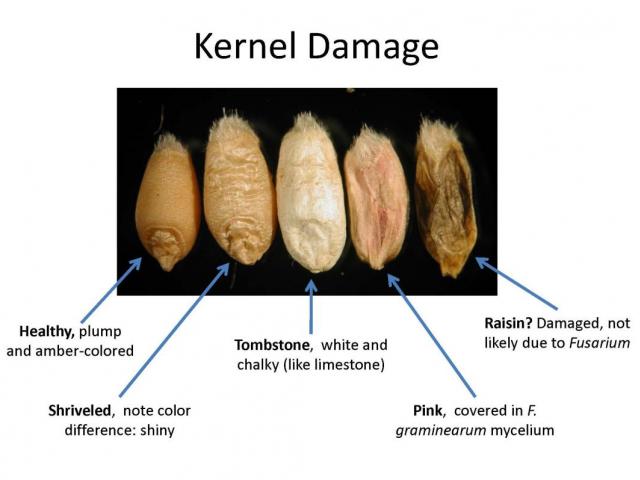Reducing risk of wheat quality losses due to Fusarium head scab at harvest
Fusarium head scab symptoms are being seen in some Michigan wheat fields. Harvest strategies can significantly reduce the disease’s threat to grain quality.

Some high levels of Fusarium head scab are currently being found in Michigan wheat fields. Head scab is particularly high in areas that received adequate or excessive rainfall during the past month. This includes many fields in parts of central, southern and western Michigan. Relatively little evidence of scab has been found in the excessively dry areas of the state including the Saginaw Valley and Thumb regions.
While Fusarium head scab can lead to some yield reduction, the greatest financial losses come from price discounts imposed on infected grain that contains a toxic by-products of the fungus referred to as DON (or Vomitoxin). Generally, soft white and soft red wheat are discounted when DON levels exceed 1 ppm and 2 ppm, respectively.
Fields at greatest risk to disease and discounts are those that have varieties possessing little resistance to the disease and where a preventative fungicide was not used at flowering. However, as is the case in some fields this year, weather favorable to the disease easily trumps best management practices.
The main symptom of Fusarium infected heads is bleached glumes on part or all of the grain head. This is most easily seen just as the field begins to turn or when the kernels are in the late milk or early dough stage. Sometime, pinkish-orange fungal growth can also be seen. It may be reasonable to suggest that the disease is relatively severe where there is one or more scabby head per foot of row. Where there is less than one infected head in ten feet of row, there may be little accumulation of DON. However, it is not possible to arrive at a reliable estimate of DON levels based on the number of scabby heads as the disease and toxin levels can sometime progress until the grain is dried.
Inspecting harvested grain can also be an indication of the severity of scab. Fusarium-damaged kernels will often be shrunken and discolored (see illustration below). Occasionally, kernels that appear healthy may also contain Fusarium and potentially DON, particularly when infection occurs late in the maturation process.

Illustration from Pierce Paul, Ohio State University.
Where scab is prevalent and high DON levels are anticipated, there are several measures a grower can take at harvest time. The most important are those directed at reducing the amount of chaff and shrunken, scabby kernels from the load.
- Maximize threshing efficiency by making appropriate adjustments and repairs to combine.
- Slow combine ground speed to insure that threshing process is as complete as possible.
- Use the combine’s maximum fan speed to remove as much chaff and as many light-weight kernels as possible.
- Where the severity of scab varies across a field, harvest and load the grain from each area separately.
- Start harvesting as soon as grain can be thoroughly threshed. This might mean starting when the grain is 18 to 20 percent moisture depending on variety and combine.
- Dry grain as soon as possible using heated air (DON is able to develop in grain as low as 18 percent moisture).
Additional resources:
Scabby wheat gain? Increasing your fan speed may help Pierce Paul, Ohio State University
Harvest and storage strategies to minimize Fusarium in 2013 Spieser, Johnson, & Tenuta, Ontario Ministry of Ag



 Print
Print Email
Email